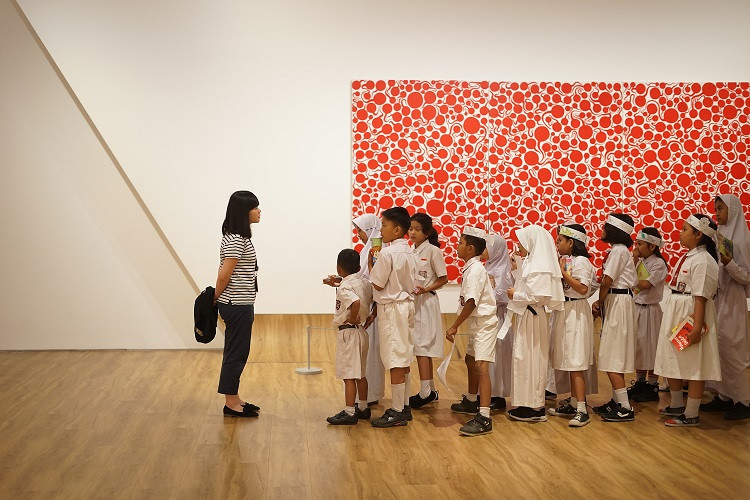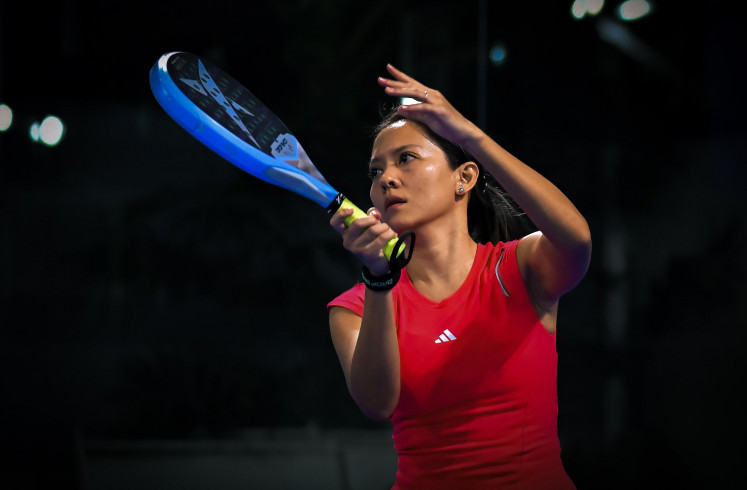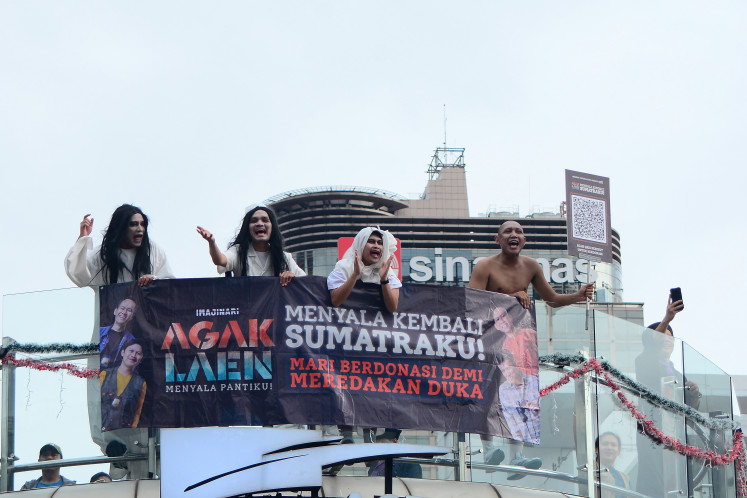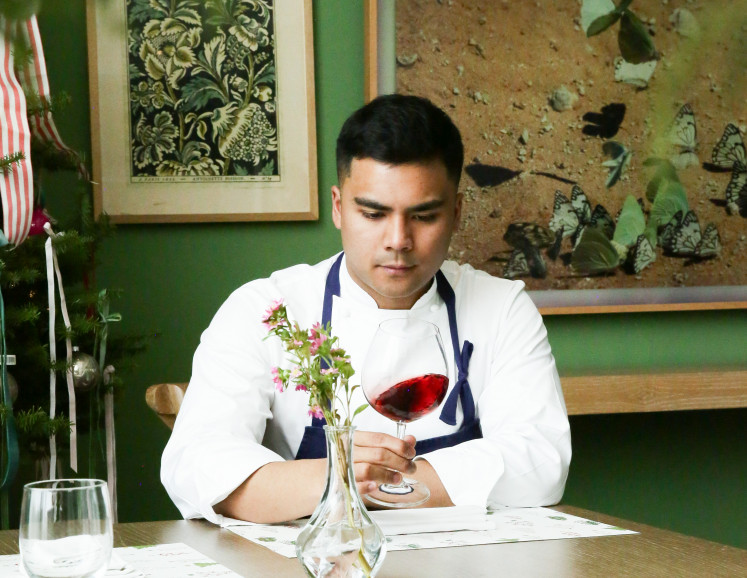Popular Reads
Top Results
Can't find what you're looking for?
View all search resultsPopular Reads
Top Results
Can't find what you're looking for?
View all search resultsThis museum believes art is for all
Museum MACAN wants art to be enjoyed by everyone, and it has plans to make that happen.
Change text size
Gift Premium Articles
to Anyone
In the era of social media and selfies, pretentiousness and elitism are no longer relevant for promoting art.
Take the Museum of Modern and Contemporary Art in Nusantara (Museum MACAN) in Jakarta as an example.
Museum MACAN, a nonprofit organization founded by businessman and philanthropist Haryanto Adikoesoemo, is Indonesia’s first modern and contemporary art museum.
It was created not only to house Adikoesoemo’s personal collection of more than 800 international and Indonesian works of art, including pieces by the likes of Andy Warhol and Keith Haring, but to also create a space where international works could be exhibited in Indonesia, to raise the international profile of local art and to promote art education and appreciation among people from a range of backgrounds.
The number of high quality and carefully selected artworks at Museum MACAN has made it a go-to place for art-loving millennials and hipsters in Jakarta, because – unlike most art museums in the world that seek to rein in the selfie culture – Museum MACAN has decided to embrace it.
Museum MACAN’s visitors are typically below the age of 30, and, like their peers, these young people like to take selfies with the artworks, most of which will likely end up on Facebook and Instagram.
Museum MACAN director Aaron Seeto is baffled by the selfie phenomenon but welcomes it with open arms.
“I have no problem with selfies, because this is how people communicate now,” the Australian-born Seeto told The Jakarta Post.
“People are sharing images, so opening the museum has been one way in which that curiosity has been harnessed toward art appreciation.”
Many museums in the Western world have to contend with rapidly aging populations, but Indonesia has a relatively young population, which largely shapes the way the nation communicates, particularly through social media.
Seeto said women between the ages of 18 and 29 years made up more than 70 percent of the museum’s visitors. For many of them, the experience is the first time to set foot in a museum. This, according to Seeto, is an opportunity for Museum MACAN to operate in a different way to more “traditional” art museums.
In a recent lecture organized by the Indonesian Heritage Society, Seeto spoke of the importance of supporting what he calls “art for all”, which is making art and art education more accessible to the general public.
“One of the preconceptions about art is that it’s only of interest to people of a particular age or social standing, whereas I think that people from all types of backgrounds should be able to engage with art,” Seeto said.
“We believe that through art appreciation and education, people can understand how creativity might be an important part of their lives, and also understand the role of empathy.”
“When you look at and think about an artwork, you might better understand the historical period it was made in, as well as the social and political concepts it communicates. In a big democracy like Indonesia, that is such an important thing; because of the multilingual and multireligious context, tools to understand other people’s viewpoints are very important.”
Education is one of the driving forces behind Museum MACAN’s creation, and because of this, the organization offers a range of educational programs to suit students of all ages.
In addition to visiting teachers and classrooms and offering school tours at the museum, a major sponsor came on board last year to help establish the museum’s Sponsored School Visit program, designed to support those who may not be able to visit a museum.
Through a vetting process by which the museum identifies the schools that have an “ongoing interest in developing art education”, a number of children are selected to visit the museum for free. Last year, more than 1,000 children from 109 schools visited Museum MACAN free of charge.
Museum MACAN also offers an educator’s forum, where a regular group of teachers can tour the museum each time a new exhibition is opened and speak to the curators.
“We also develop educational activities that are distributed to the teachers, so we are also providing them with information and processes that they could adapt for their classrooms,” Seeto said.
Within its premises, Museum MACAN features an art space for children.
“Twice a year we commission an artist to make an installation specifically for children [...] We want to demystify some of the hesitation people might feel when they go into a museum and deliver an education where the kids feel comfortable and are engaged,” Seeto said.
Museum MACAN also offers educational programs for the general public, where members of the Indonesian arts community can share their knowledge with others.
“So, we started this project very recently called MACAN A to Z, which is a 40-minute presentation in Indonesian by experts talking about keywords that need some explanation,” Seeto explained.
“The first one was ‘A’ for ‘Abstract’, we had ‘F’ for ‘Feminism’, there’s a whole variety of concepts that we cover in a serious but light-hearted way.”
Seeto said he was seeing a growing appetite for the arts in Indonesia, particularly among the younger generations who use social media to create and share images.
He is also seeing more international interest in Indonesian art, which he said was not just due to the fact that TIME Magazine named Museum MACAN one of the world’s Top 100 Places to Visit in 2018 – the only Indonesian establishment to make the list.
“I think there is much greater demand to understand what goes on in Indonesia, but that is not always reflected in the places where they live or the museums or the cultural experiences they have in Europe or America or even in Australia,” he said.
“This is why our website and publications are very important, because they allow people outside Indonesia to access that information.”
This growing national and international interest in Indonesian art, and the arts more generally, is one that Seeto hopes Museum MACAN will help develop in the future through its educational programs.
“The role of art has always been important, but especially now, in terms of art’s ability to help us see other perspectives and to participate in a global context,” he said.
“I think the ability to appreciate art leads to a better understanding of the role of creativity and empathy in society, and this is also very important for young minds as well. I hope that creativity will continue to be valued and help contribute to people’s daily lives.” (hdt)
The writer is an intern at The Jakarta Post.











